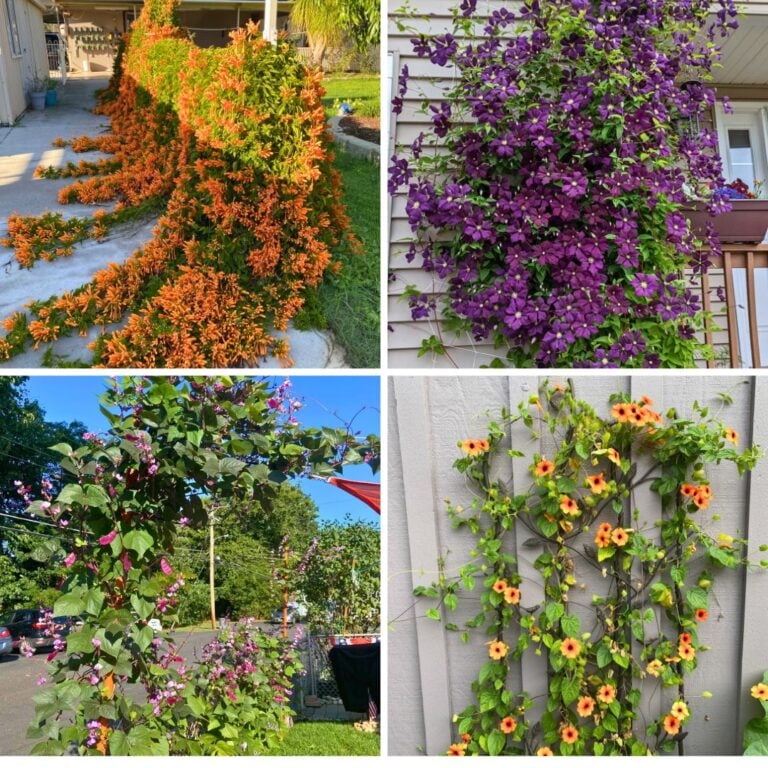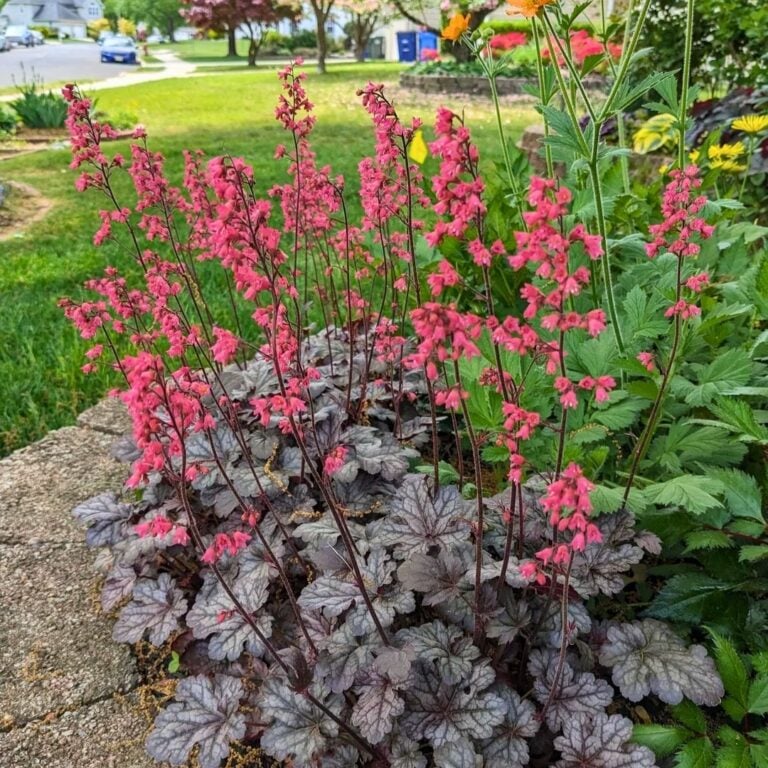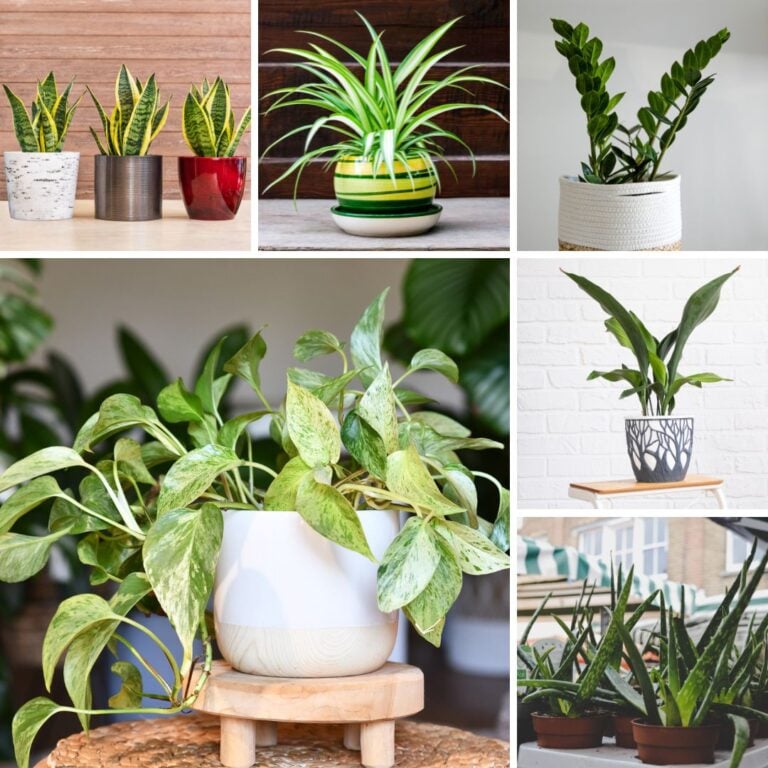15 Full Sun Container Flower Ideas
I love how just a few bright containers can totally transform a sunny patio or balcony.
When the sun’s out all day, the right mix of plants and pots can turn any spot into a lively, colorful corner that just feels good.
You can create your own full sun container garden that stays bold and beautiful, honestly, all season long.
In this article, I’ll share some easy ideas for mixing colors, shapes, and textures that thrive in strong sunlight.
From classic blooms to unexpected combos, each idea has its own charm and brings a bit of warmth to any outdoor space.
Please note: Simplify Plants is reader-supported. As an Amazon Associate, I earn from qualifying purchases made by our readers with no extra cost added to you all! Some links in the post are affiliate links and I get a commission from purchases made through links in the post.
1) Vibrant Geraniums

There’s something about geraniums—those bold red, pink, or white blooms just pop against terracotta pots. The warm clay color really makes the flowers stand out.
I always pick sunny spots for my geraniums. They love bright light and the terracotta helps keep their roots happy and not too wet.
Deadheading old flowers and giving them a little fertilizer every few weeks keeps the color going strong. It’s not much work, and the payoff is a steady burst of blooms.
I like clustering several terracotta pots together for a more cheerful look. Mixing a few different geranium shades adds variety but still feels tidy.
When it gets chilly, I move my pots somewhere sheltered to keep them safe from frost. With a bit of care, these sun-loving plants stay healthy and colorful year after year.
2) Trailing Petunias for Cascading Color
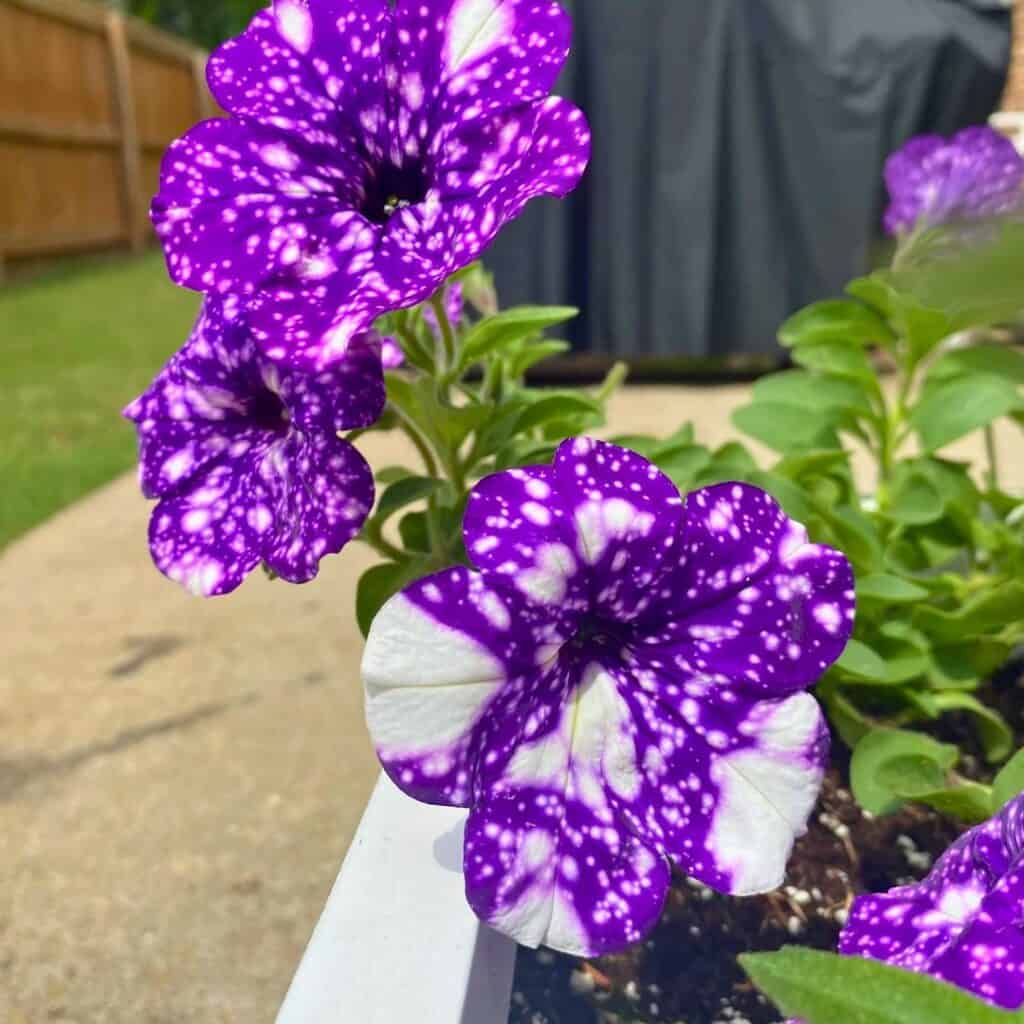
Trailing petunias are my go-to when I want a container that just overflows with color. The way they spill over the edges gives any pot a soft, full look.
Their blooms come in pink, purple, white, and red, so you can match any vibe or mood. I usually plant them in hanging baskets or tall containers so the flowers can really cascade down.
Petunias grow fast and fill in empty spots quickly, which is perfect for instant color. They really do best with at least six hours of sunlight every day.
I water them often, but I let the soil dry out a bit in between. Too much water isn’t great for their roots, so I always poke my finger in the soil first.
A well-draining potting mix keeps everything balanced. Every couple of weeks, I feed them with a balanced liquid fertilizer.
Deadheading faded flowers helps new ones show up faster. It keeps the plant looking neat and colorful, too.
I like mixing petunias with other sun-lovers like verbena or calibrachoa. The combo adds texture and layers of color, and it’s honestly just a happy sight.
When there’s a breeze, the flowers sway and catch the light. It brings a lively, cheerful energy to patios or balconies.
With a little care, trailing petunias bring lasting color and charm to any sunny container.
3) Bright Marigolds in Rustic Containers

Marigolds are like instant sunshine for any spot that gets a lot of light. Their bold orange and yellow blooms stay cheerful, even in the heat.
I love planting them in rustic containers—old buckets, wooden crates, or clay pots with a few chips. The rough textures make the flowers stand out even more.
I always use a well-draining potting mix and make sure the container has holes at the bottom. Marigolds don’t like soggy roots, so I water only when the top inch of soil feels dry.
Mixing different types of marigolds in one container gives a nice variety of heights and shades. Smaller French marigolds fill the edges, and the taller African ones add some drama.
Deadheading faded blooms every few days keeps new buds coming. I toss in a little fertilizer every few weeks for extra energy.
I like to set these rustic pots on porch steps or in patio corners where they’ll soak up the sun. The combo of bright petals and weathered containers just feels cozy and inviting.
4) Lush Lavender for Fragrant Blooms

Lavender is a favorite of mine for both its looks and its scent. The soft purple flowers bring color, and the fragrance instantly makes any space feel relaxing.
Lavender needs full sun and well-drained soil. I use a big pot with holes at the bottom and mix in some sand to keep things light.
I only water when the top inch of soil feels dry. Overwatering isn’t great for lavender, so I try to stay on the cautious side.
Once it’s settled in, lavender can handle short dry spells. I trim the plant after it blooms to keep it tidy and encourage new growth.
The trimmed stems are great for drying and using in crafts or sachets. That way, the scent sticks around even longer.
Lavender pairs nicely with rosemary, sage, or even some small ornamental grasses. They all enjoy the same sunny, dry conditions, so it’s an easy combo.
I keep my lavender somewhere it’ll get at least six hours of sun. The more light, the better the blooms and the fragrance.
When it gets cold, I move the pot close to a wall or bring it inside near a window. Lavender can handle a bit of chill, but strong frost can be rough on it.
Every spring, I refresh the top layer of soil and see if the plant needs more room. If the roots are crowded, I size up the pot—healthy roots mean more flowers.
Lavender adds beauty and scent to my space, and it’s simple to care for. Plus, bees and butterflies love it, which is always a bonus.
5) Colorful Zinnias in Ceramic Planters
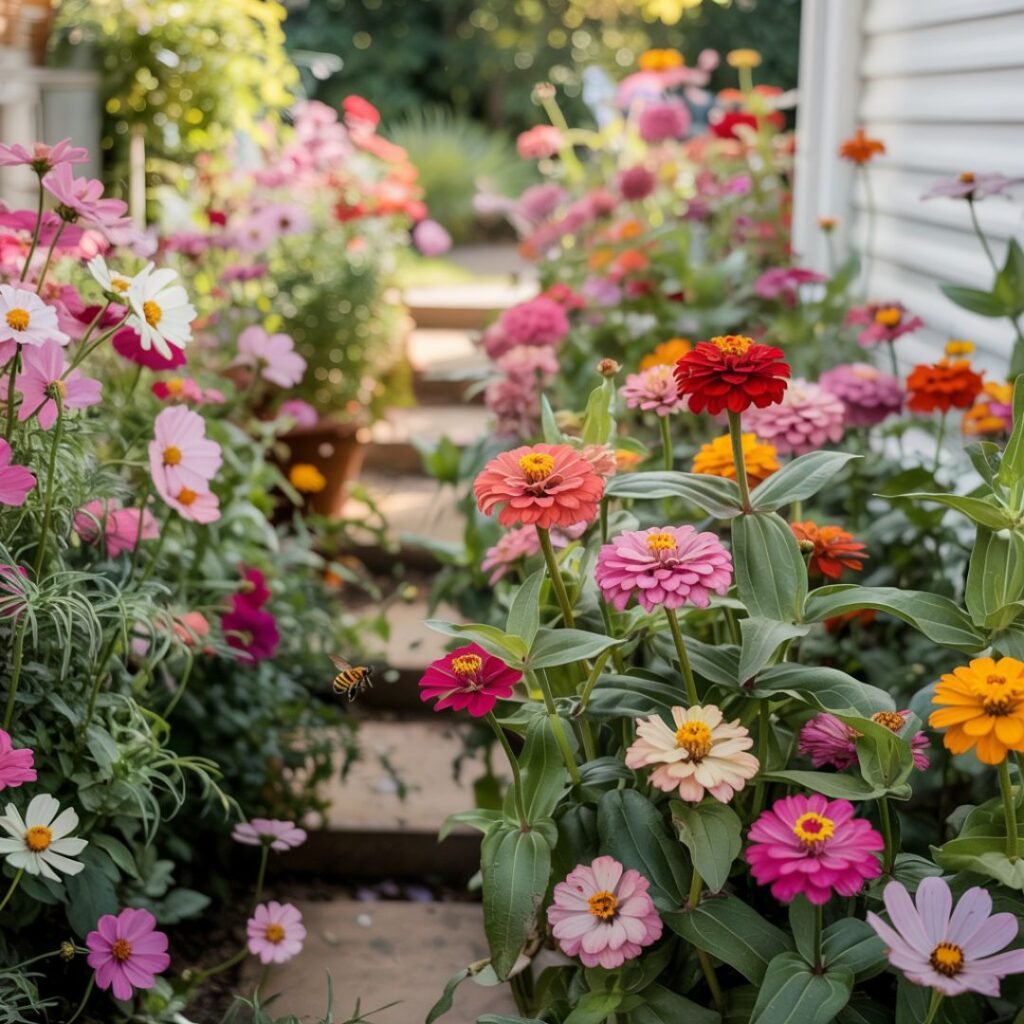
Zinnias are just pure joy in a pot. Their bright blooms come in so many colors—red, orange, pink, yellow, white—you name it.
I like ceramic planters for zinnias because they hold moisture well and come in all kinds of fun colors. A glossy blue or white pot really makes the blooms stand out.
Zinnias want full sun, at least six hours a day. I water when the top inch of soil is dry and make sure there’s good drainage.
Mixing different zinnia types in one pot creates a nice blend of heights and colors. Tall ones in the middle, shorter ones around the edges—it just works.
Deadheading faded flowers keeps new buds coming and the plant looking tidy. Sometimes I add trailing plants like sweet alyssum or creeping Jenny to soften the edges.
Zinnias attract butterflies and bees, which adds a bit of magic to my patio. I love watching them flit around on warm afternoons.
I always start with fresh potting mix and a little slow-release fertilizer. Zinnias don’t need much, but a little boost helps them stay strong.
When it gets really hot, I move the planters where there’s some air flow to keep mildew away. Regular care keeps them looking bright all summer.
Honestly, zinnias in ceramic planters can make even the smallest space feel alive. They’re easy, rewarding, and always cheerful.
6) Sun-loving Salvias for Bold Hues
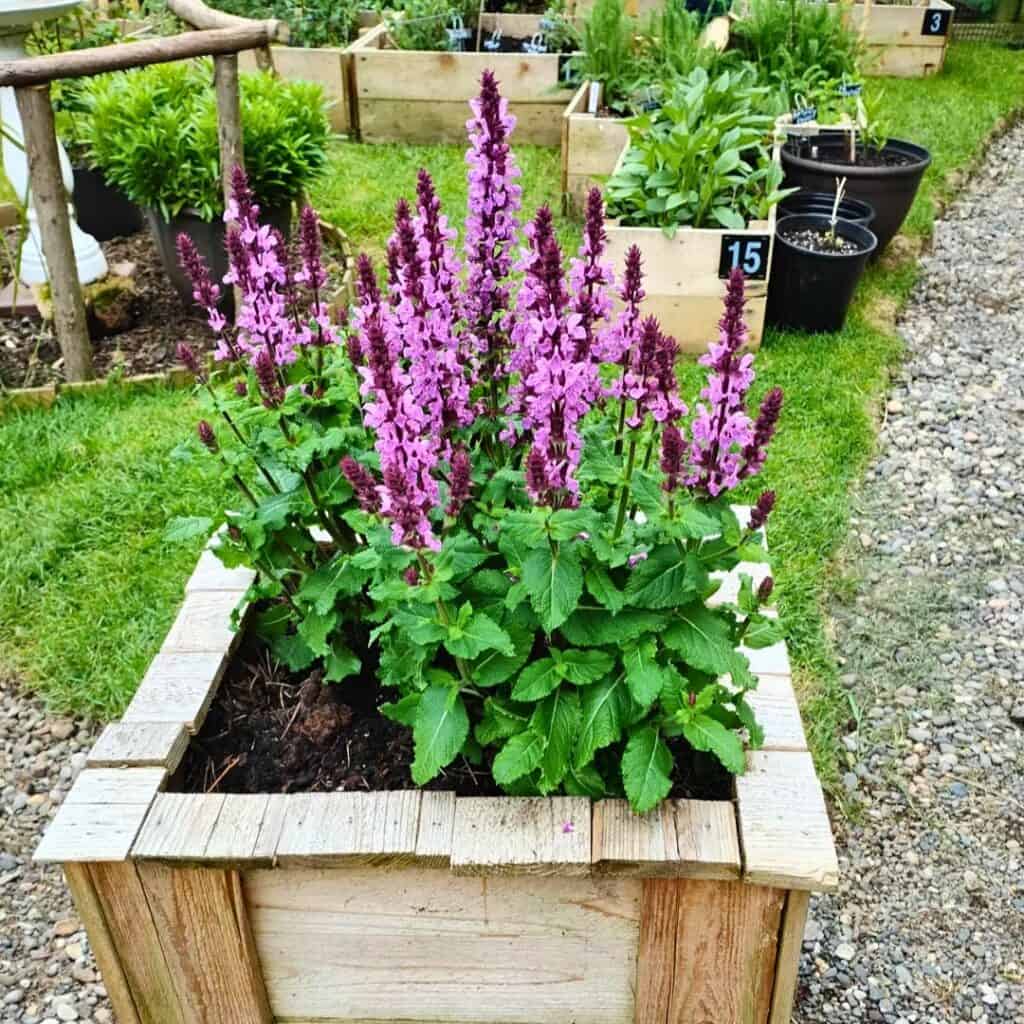
Salvias are a real showstopper on my patio. They love full sun and don’t mind the heat, so they’re perfect for containers.
Their long flower spikes attract bees, butterflies, and even hummingbirds. It’s like a little wildlife party out there some days.
I’m a fan of Salvia guaranitica for its deep blue flowers—they really pop against the green leaves. It grows fast and keeps blooming all season.
Salvia splendens gives bold red or purple blooms, perfect for a cheerful look. For something softer, Salvia farinacea (mealycup sage) has pale blue flowers that pair well with yellow or white.
I use a well-draining potting mix and water when the top inch of soil is dry. My containers always get at least six hours of direct sun.
Every few weeks, I give salvias a bit of fertilizer to keep the flowers coming. I sometimes mix them with petunias, lantanas, or verbena for a full display.
Their upright shape adds height, while other plants spill over the sides. It looks lively without feeling crowded.
If I’m after a more natural vibe, I let salvias grow with ornamental grasses. The contrast between the tall spikes and fine blades adds texture.
With so many types and colors, there’s always a salvia that fits my mood. Whether I want rich reds, deep blues, or soft purples, these plants always deliver.
7) Cheerful Calendulas in Hanging Baskets

Calendulas are like a burst of sunshine, with bright yellow and orange petals that just make me smile. Hanging them in baskets instantly makes a porch or balcony feel warmer.
They thrive in full sun, so I pick the sunniest spots. I water regularly but always make sure the soil drains well—too much water isn’t their friend.
I use lightweight baskets with good drainage holes to keep roots happy. Mixing in a bit of compost gives the plants a little extra energy.
Calendulas bloom best if you deadhead the faded flowers. I usually do this once or twice a week, and it keeps the plants looking neat.
These flowers attract bees and butterflies, adding even more life to the garden. I like hanging a few baskets near my seating area to enjoy the color up close.
When it cools down, I trim back the plants and collect some seeds for next year. It’s a simple way to keep the cycle going and feels pretty satisfying.
Sometimes I mix calendulas with trailing plants like ivy or lobelia. The gold blooms with green vines look fresh and cheerful, and it’s such an easy way to fill out a basket.
Calendulas might be simple, but they always brighten my day. Their easy care and vivid color make them a top pick for sunny hanging baskets.
8) Dazzling Dahlias in Large Pots

I’ve got a soft spot for dahlias in big containers—they really bring instant color and height to my patio. Their bold blooms come in so many shapes and shades, from soft pinks to deep reds.
Mixing different varieties? That’s when things get bright and cheerful all season long. I always go for a large, sturdy pot so the roots have plenty of room.
Dahlias just seem happier with space and good drainage. I fill up the container with rich potting mix and toss in some compost for a strong start.
These flowers love full sun, so I make sure their pots get at least six hours of sunlight. Regular watering keeps the soil just moist enough—never soggy though.
I poke my finger into the top inch of soil to check before watering again. For more blooms, I deadhead faded flowers every few days.
It only takes a moment and really helps the plant stay neat and push out new buds. I also feed them with a balanced fertilizer every couple of weeks during the growing season.
Pairing dahlias with low-growing plants like sweet alyssum or creeping Jenny at the base adds texture. It fills the pot nicely, and honestly, the mix of colors and shapes always gets noticed.
When fall rolls around, I let the foliage die back before lifting the tubers. I stash them in a cool, dry spot for winter, then replant in spring—no need to buy new ones each year.
Growing dahlias in pots means I can move them around for the best light or just to shake up my patio’s look. They bring a burst of energy to any sunny corner, and I never get tired of watching those big blooms open up.
9) Radiant Lantanas for Butterfly Gardens

There’s just something about Lantanas—those clusters of tiny, colorful blooms light up my patio. Their mix of yellow, orange, pink, and red flowers makes any container feel happy.
These plants thrive in full sun, which is perfect for those warm, bright spots. I usually pick compact varieties for containers so they don’t get too wild.
They look great in pots, hanging baskets, or even mixed with other sun-lovers. Best part? They’re super low-maintenance—I just water when the soil starts to dry out.
Butterflies seem to adore Lantanas. The bright colors and sweet nectar pull them in all season.
If I put a few containers near my favorite chair, I get to enjoy both the flowers and the butterflies up close. I like mixing Lantanas with plants that have contrasting textures, like dusty miller or trailing verbena.
That combo adds depth and keeps my containers looking lively. The flowers bloom nonstop from late spring through fall, so there’s always color.
When flowers fade, I give them a light trim to encourage more blooms. Lantanas handle heat and drought well after they’re settled, so I don’t stress if I skip a watering here and there.
Their resilience makes them a favorite for sunny gardens. If I’m craving even more color, I’ll mix different Lantana types in one big pot.
The result? A bright, eye-catching display that fits right in on a balcony or porch. Plus, they attract butterflies, bees, and sometimes hummingbirds—my garden always feels alive.
10) Fiery Red Begonias in Window Boxes

I can’t get enough of how fiery red begonias light up a window box. That bold color against green leaves? It’s hard to miss from the street.
Even a small window ledge feels lively with these compact blooms. I stick with wax begonias since they handle full sun and keep blooming through summer.
Their thick, glossy leaves help them stay fresh, even on those scorching days. I water regularly, just enough to keep the soil moist but not soggy.
For a fuller look, I mix red begonias with some trailing vines like ivy or sweet potato vine. The vines soften the box’s edges and make everything feel more lush.
The red flowers really pop against all that green. I use a light potting mix that drains well to keep the roots happy.
A slow-release fertilizer keeps the blooms coming. Every few weeks, I pinch off faded blooms to help new ones grow.
These window boxes add a pop of color to my home’s exterior without much fuss. When the sun hits, the red petals almost seem to glow.
It’s such a simple way to make my windows look welcoming and bright.
11) Golden Coreopsis for Sunny Spots
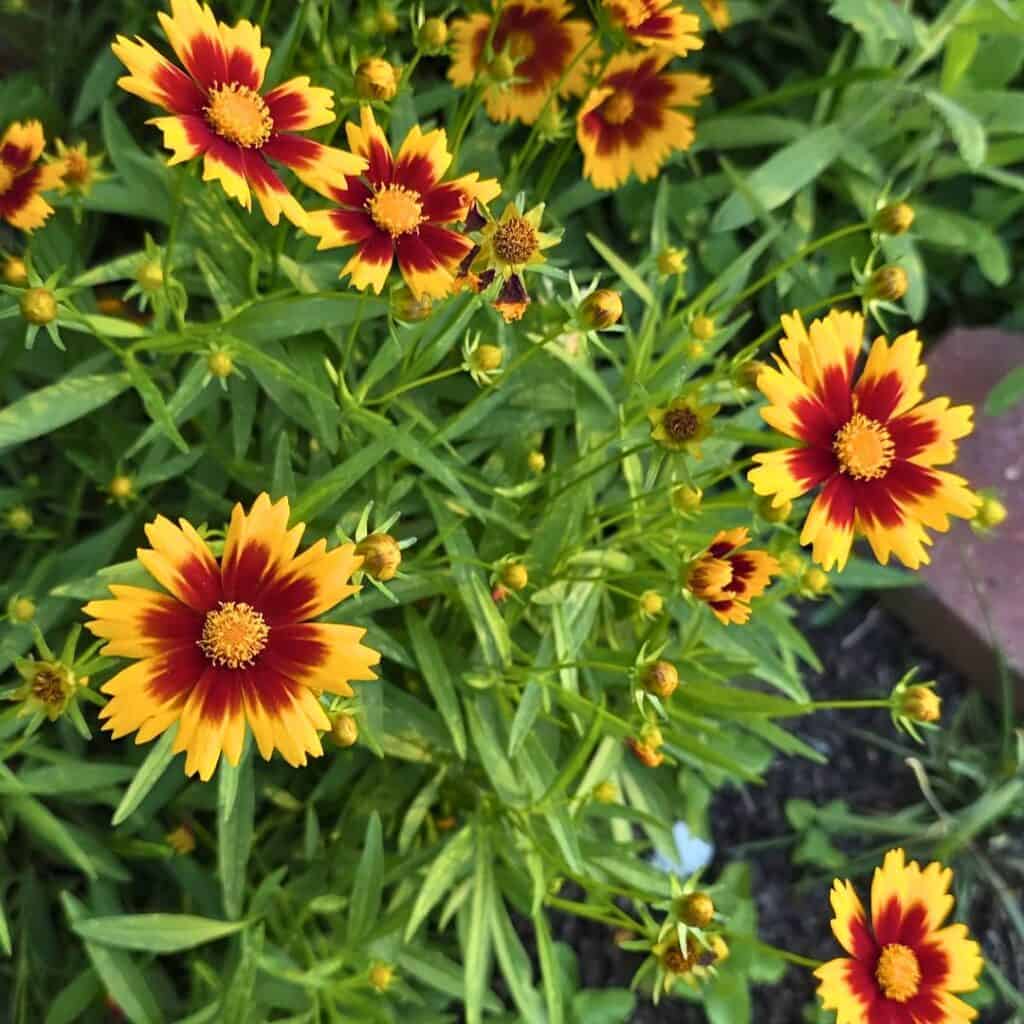
I’m a big fan of Golden Coreopsis when I want lasting, bright color. Those cheerful yellow blooms look fantastic in containers and thrive in full sun.
They bring a warm, sunny vibe to patios, balconies, or even the edge of a garden. I use a well-draining potting mix and make sure my containers have good drainage holes.
Coreopsis isn’t a fan of soggy soil, so I only water when the top inch feels dry. This keeps the roots healthy and happy.
The flowers bloom for weeks and always seem to attract bees and butterflies. I like mixing them with purple or blue plants, like salvia or lavender, for a nice color contrast.
The bright yellow petals really stand out next to cooler tones. I trim off faded blooms to keep the plant looking fresh and full.
It also helps extend the blooming season into late summer. Coreopsis handles heat like a champ, so I don’t stress when the days get hot.
It’s a low-maintenance choice that gives steady color with minimal effort. For a fuller look, I’ll sometimes plant multiple Coreopsis varieties together.
Some have a deeper gold, others are more lemony. The mix adds depth and keeps things interesting.
If the plant gets crowded, I divide it in early spring. That keeps it strong and blooming well each year.
Pairing Coreopsis with ornamental grasses or succulents adds texture. The combo of soft petals and structured foliage makes the container more dynamic.
It’s a simple design trick that just works in bright sunlight.
12) Purple Verbena in Decorative Tubs
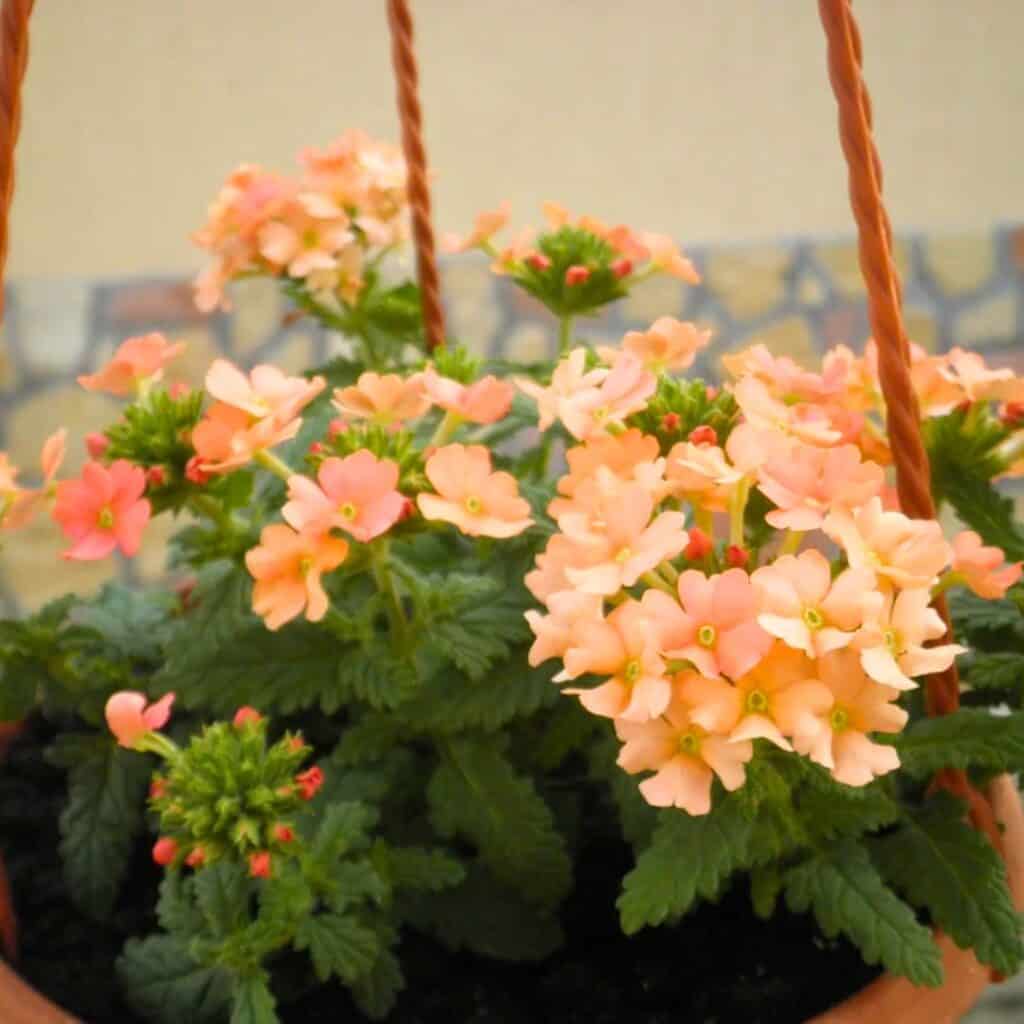
There’s something special about purple verbena—it adds instant color to any sunny corner. Those small, clustered blooms stay bright all season, and that deep purple looks amazing with green leaves.
When I plant them in decorative tubs, they really become a cheerful focal point on my patio. These flowers love full sun and need well-drained soil.
I always check that tubs have drainage holes so water doesn’t pool at the bottom. Verbena hates soggy roots, so I only water when the top inch of soil is dry.
I like to mix up the look by using different tub styles. Metal tubs feel rustic, while a painted ceramic one is more modern.
Bright purple flowers stand out no matter what container I pick. To keep them blooming, I trim faded flowers every week.
That little bit of maintenance helps new buds form and keeps things tidy. I’ll feed them with a light fertilizer once a month during summer.
Purple verbena pairs nicely with white alyssum or yellow marigolds. The contrast makes tubs look lively and balanced.
Placing them near seating areas means I get to enjoy their soft scent up close. Even though verbena is pretty low-maintenance, I check for pests every few weeks.
A quick rinse with water is usually enough to keep the leaves clean and healthy. When the season winds down, I move the tubs somewhere sheltered.
In warmer areas, verbena might survive a mild winter, but I usually treat it as an annual and replant in spring. Using decorative tubs gives me flexibility to rearrange my space.
If a spot gets too shady, I just move the tubs to chase the sun. It’s a quick way to refresh my setup without much work.
Every time I spot those bright purple blooms, I feel a little proud of how easy they are to care for. They’re proof that even small containers can bring a ton of life and color to a sunny space.
13) Orange Nasturtiums for Edible Blooms
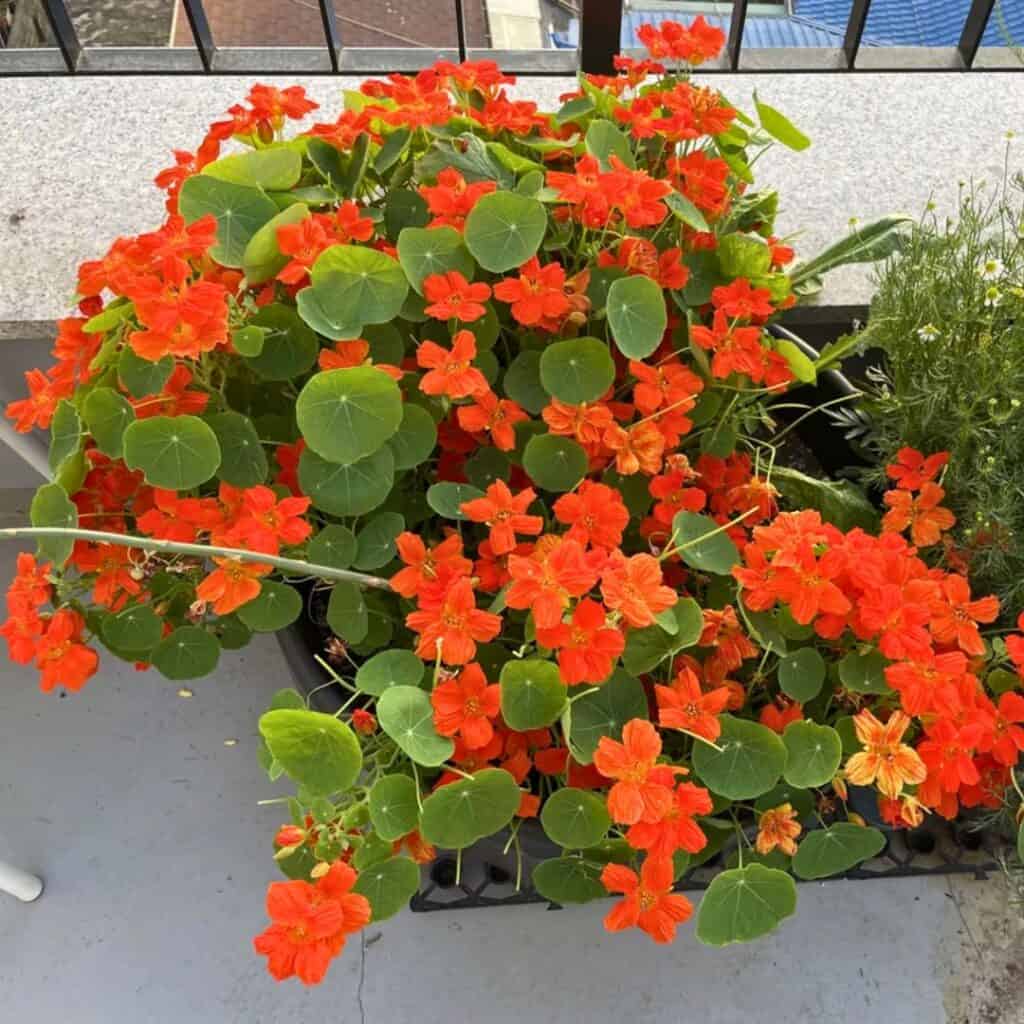
I can’t help but love orange nasturtiums for the burst of color and flavor they bring to my patio. Their round leaves and bold flowers make any container look cheerful and full of life.
These plants grow fast and don’t ask for much, which is great if you’re a beginner. I set my nasturtiums in full sun for the best blooms.
They like well-draining soil and only need a light touch with the watering can. When I let the soil dry out a bit between waterings, the plants seem to thrive and pump out more flowers.
The best part? Nasturtium blooms are edible. I love picking the flowers to toss in salads for that mild, peppery zing.
The leaves and seeds are edible too, so there’s a lot to experiment with in the kitchen. I often mix nasturtiums with other sun-lovers like marigolds or petunias.
The orange blooms really pop against all that green, and the whole container just feels lively. Plus, they attract bees and butterflies, which gives a nice boost to nearby plants.
When flowers fade, I snip them off to keep new ones coming. It’s a simple step, but it really keeps the plant blooming through the season.
If I want a different look, I’ll use trailing varieties that spill over the pot’s edge. They make a soft, flowing shape—perfect for brightening up small spaces.
Whether in hanging baskets or big containers, nasturtiums always add a happy splash of color and a bit of charm.
14) Bright Blue Plumbago in Large Containers
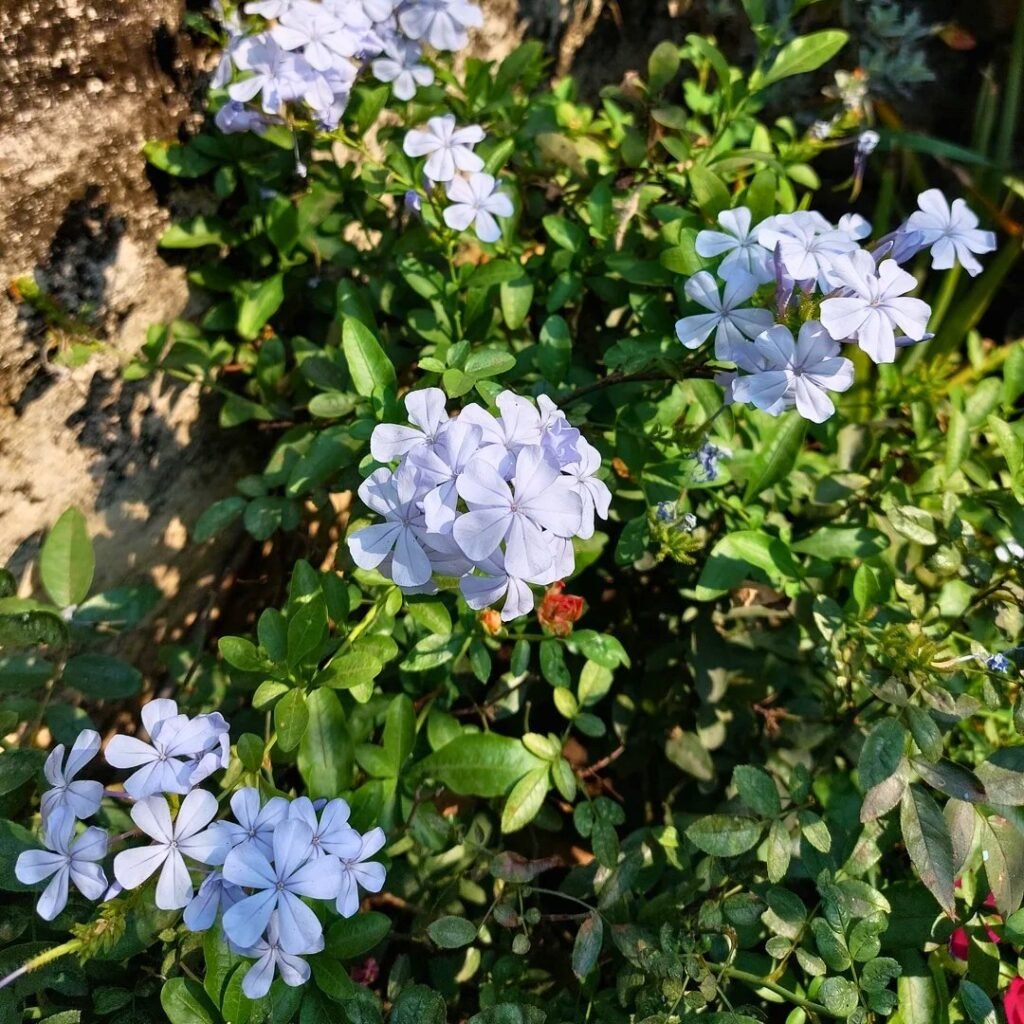
There’s nothing quite like Bright Blue Plumbago to light up a sunny patio or balcony. Those clusters of soft blue flowers look so cheerful against green leaves, and they just keep blooming for months.
I always plant mine in large containers so the roots have plenty of room. The extra space helps the plant stay healthy and keeps it from drying out too quickly in the sun.
This plant thrives in full sun and warm temps. I make sure it gets at least six hours of direct sunlight every day.
When it’s got enough light, it just keeps pumping out color. I use a well-draining potting mix and water when the top inch of soil feels dry.
Too much water can be a problem, so I let it dry a bit between waterings. Fertilizing every few weeks keeps the blooms coming strong.
I stick with a balanced, slow-release fertilizer and follow the label. I like to prune lightly after each bloom cycle.
It helps shape the plant and encourages fresh growth. Plumbago bounces back quickly with more flowers.
Bright Blue Plumbago looks fantastic paired with white or yellow flowers in nearby pots. That contrast really makes the blue pop.
Grouping a few containers together gives a bright, inviting feel. It’s such an easy way to bring a touch of tropical color to any sunny space.
15) Sunny Yellow Sunflowers in Tall Pots

There’s just something about sunflowers—they brighten up any space the moment you add them. Their tall stems and those bold yellow petals? They’re just made for full sun containers.
I like using tall pots since they create a cheerful focal point that really pulls your eye in. Usually, I go for dwarf or compact varieties so the plants don’t end up too big for the container.
You still get those classic sunflower blooms, but they’re much easier to manage on a patio or balcony. I make sure the pots are sturdy enough to handle their height and weight—nobody wants a toppled sunflower.
Good drainage is a must; sunflowers hate soggy roots. I fill the container with quality potting mix and toss in some compost for extra nutrients.
Watering is a bit of a balancing act. I water deeply, then let the soil dry out a bit before watering again.
I like grouping sunflower pots with smaller flowers in similar shades, like marigolds or zinnias. The mix of heights and colors just feels so warm and energetic.
Sometimes I’ll add a few trailing plants around the base for more texture. Sunflowers really need direct sunlight, so I always place the pots where they get at least six hours of sun.
The more sun they get, the stronger and brighter the blooms. When the flowers fade, I snip off the old blooms to encourage more growth.
Collecting seeds is kind of fun too—I save them for next season or sometimes give them to friends. Tall pots make it easier to move the plants if I need to chase the sun or shield them from wind.
I’ve found that a neutral or terracotta pot really makes those yellow petals pop. Every time I walk by my sunflower pots, they make me smile.
Their bright faces turn toward the sun, and honestly, it’s a nice little reminder of how much thrives with good light and care.
Choosing the Best Containers for Full Sun
I always look for containers that can take the heat, hold moisture, and give my plants plenty of room. The right material and solid drainage really impact how well things grow in bright sun.
Material Considerations
I tend to pick container materials that stay cool and don’t crack in hot weather. Terra-cotta pots look classic, but they dry out fast—so I use them only for plants that don’t mind a bit of drought.
Plastic containers are lightweight and hold onto moisture longer, which helps during hot spells. Metal pots can heat up quickly, so I usually line them with coconut fiber or plastic to protect the roots.
Glazed ceramic pots are great at holding water but can be heavy. Sometimes I go for fiberglass or resin containers—they’re tough and much easier to move around.
Here’s a quick guide:
| Material | Pros | Cons |
|---|---|---|
| Terra-cotta | Breathable, natural look | Dries out fast |
| Plastic | Light, holds moisture | Can fade in sun |
| Metal | Stylish, strong | Heats roots |
| Ceramic | Keeps soil moist | Heavy |
| Fiberglass | Durable, easy to move | Can cost more |
I just pick what fits my climate and how often I like to water.
Drainage and Size Tips
Every pot needs drainage holes—no way around it. If they’re missing, I’ll drill my own or add gravel at the bottom.
Good drainage keeps soil from getting soggy and helps prevent root rot. For full-sun plants, I go for larger containers so they hold more soil and moisture.
Small pots just dry out way too fast in the sun. I find a pot that’s 12–16 inches wide works for most flowers and herbs.
I also check that the pot’s deep enough for the plant’s roots. Shallow-rooted plants like petunias don’t need much depth, but tomatoes or dwarf shrubs need deeper pots.
And I always leave a bit of space at the top, so watering doesn’t cause a mess.
Maximizing Color and Bloom
I keep my containers lively by picking plants that love sunlight and making sure they get the nutrients they need. Color variety and proper feeding are key to keeping things looking vibrant all season.
Combining Colorful Annuals and Perennials
Mixing annuals for quick, bold color with perennials for lasting structure just works. Annuals like petunias, zinnias, and marigolds bloom nonstop in full sun.
Perennials such as coreopsis, salvia, and gaillardia come back each year and fill in gaps as annuals fade. I always group plants with similar sunlight and water needs so they grow evenly together.
Pairing drought-tolerant perennials with heat-loving annuals in the same pot keeps things simple. It also stops one plant from taking over.
To make colors pop, I use contrast and repetition. A pot with purple salvia, yellow marigolds, and white alyssum stands out without looking chaotic.
Repeating one or two colors across different containers ties the whole display together visually.
| Type | Example Plants | Bloom Time | Sun Needs |
|---|---|---|---|
| Annuals | Petunia, Zinnia, Marigold | Spring–Fall | Full Sun |
| Perennials | Salvia, Coreopsis, Gaillardia | Summer–Fall | Full Sun |
Fertilizing for Vibrant Growth
Container plants need regular feeding since nutrients wash out with all the watering. A balanced, slow-release fertilizer keeps growth steady and colors bright.
I usually mix it in when I plant and refresh it every few months. For a quick boost, I’ll use a liquid fertilizer every couple of weeks.
I like to do this in the morning when the soil’s already a bit damp—less risk of burning the roots.
If I notice pale leaves or weak blooms, it’s usually a sign something’s missing—maybe nitrogen or phosphorus. Adjusting the fertilizer based on what I see helps keep containers full and colorful.
Frequently Asked Questions
I really enjoy making bright container gardens that stay healthy and colorful all season long. Picking sun-loving plants, using durable containers, and following some simple care routines like watering and fertilizing makes a big difference.
What are some colorful plants that thrive in full sun containers?
I’m a fan of geraniums, petunias, marigolds, lavender, and zinnias. They all handle strong sunlight and heat, and come in so many bright colors.
How do I choose the right container for my sun-loving plants?
I go for containers with good drainage holes and sturdy materials like terracotta, ceramic, or resin. Light-colored pots help keep roots cooler by reflecting heat.
Matching the pot size to the plant’s growth is important too—no one wants a crowded container.
Can you suggest any low-maintenance plants for a sunny container garden?
Definitely! Succulents, lantanas, and portulacas are great because they don’t need much water and still bloom beautifully in full sun. Lavender is another easy favorite—once it’s established, it barely needs attention.
What are the best soil and fertilization practices for vibrant container gardens in full sun?
I stick with high-quality potting mix that drains well but holds some moisture. Mixing in slow-release fertilizer at planting time and adding liquid feed every few weeks keeps everything looking strong.
How often should I water plants in full sun containers to keep them looking great?
I check the soil every day during hot weather. If the top inch feels dry, I water deeply until it drains out the bottom.
Morning watering is best—it gives the plants time to soak up moisture before the heat of the day kicks in.
What are some creative design tips for arranging a full sun container display?
I like to mix tall, medium, and trailing plants—it just feels more lively that way. For example, upright geraniums look great alongside trailing petunias.
If there are bare spots, I’ll tuck in some marigolds or zinnias. Grouping containers of different sizes can really add some unexpected depth and interest, too.
Recommended Garden Supplies
| Product Image | Our Recommended Gardening Supplies | Check Offers! |
|---|---|---|
Top Top
Top
Top
Top
Top
Top
Top
Top | rePotme Houseplant and Tropical Classic Potting Soil Mix | Check Offer On Amazon |
 Top
Top
Top
Top
Top
Top
Top
Top | Espoma Organic Indoor Plant Food | Check Offer On Amazon |
 Top
Top
Top
Top
Top
Top
Top
Top | GooingTop LED Grow Light 6000K Full Spectrum Clip Plant Growing Lamp | Check Offer On Amazon |
 Top
Top
Top
Top
Top
Top
Top
Top | Soil Moisture Meter | Check Offer On Amazon |
 Top
Top
Top
Top
Top
Top
Top
Top | Govee Hygrometer Thermometer, Bluetooth Enabled! | Check Offer On Amazon |
 Top
Top | LEVOIT Humidifiers for Large Room(Best For Plants) | Check Offer On Amazon |
 Top
Top
Top
Top
Top
Top
Top
Top | Upgraded DIY Automatic Drip Irrigation Kit, 15 Potted Houseplants Support | Check Offer On Amazon |
 Top
Top
Top
Top
Top
Top
Top
Top | Stainless Steel Heavy Duty Gardening Tool Set | Check Offer On Amazon |
 Top
Top
Top
Top
Top
Top
Top
Top | Bonide Insecticidal Soap | Check Offer On Amazon |
 Top
Top
Top
Top
Top
Top
Top
Top | Bonide 32 oz Spray Neem Oil for Organic Gardening | Check Offer On Amazon |
 Top
Top
Top
Top
Top
Top
Top
Top | Garden Safe Fungicide | Check Offer On Amazon |
Note: Some images in the articles are sourced from Reddit and Other Platforms For Reference Purpose.


